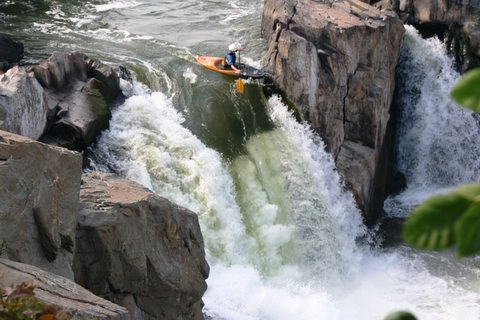I have always been a big fan of the Hit List. Not in the mafia sense (although people who tailgate or clog up the left lane should definitely have their licenses revoked). I mean having a hit list of goals: places to travel, mountains to hike, foods to try. Mine usually take shape during winter, when I’m dreaming about what I’ll do when we have more than 42 minutes of daylight and a temperature that’s comfortable for those of us who don’t happen to be sled dogs. You make a hit list because half the fun is looking forward to something. The anticipation is the best part.
While it’s always key to put old favorites on the hit list (I want to hike Franconia Ridge every year until I die), the best hit lists have things you haven’t done. The ultimate is having something that nobody’s ever done. In kayaking, we call that a “first descent” (sometimes abbreviated — if you’re a really insufferable “bro” who happens to be “stoked” — as a “first d”).
Every winter back in the early 2000s, I’d get it in my head that I wanted to do a first descent. I wanted to find a river nobody had ever done. In kayaking, in the early 2000s, it was still theoretically possible.
But it wasn’t easy. Because most of New England’s major rivers had been run for decades, and because most of the steep and dangerous rivers that you’d want to run had already been ticked off a decade before by the likes of Willie Kern, Boyce Greer, Dennis Squires, and Greg Hanlon, guys of my generation who wanted first descents were left to seek out smaller, more obscure creeks, or even individual waterfalls. So we went looking.
Back then we didn’t have Google Earth, or really even that much good information on the Internet. These were the days when the American Whitewater site for Vermont had the likely apocryphal “Adams Creek” in Putney as a featured entry. It was just a few years before that someone had told me about this new website called “Google.” So with a dearth of information online, we used things that were called “books,” which were sort of like the Internet, except with less pornography. During the winter I’d go into the bookstore in Middlebury, Vermont, haul down the biggest, most beautiful coffee table books, with titles like “Scenic Waterfall Viewing in the New England Region.” The lady at the front counter would scowl at me because I looked and smelled as though I’d just emerged from running the Otter Creek with zero point zero dollars in my wallet, which was true, but she couldn’t have known how invigorating it was to thumb furtively through a tourist’s book with an altogether different and sexier goal in mind. I wasn’t interested in scenery. I was interested in finding waterfalls that were runnable in a kayak. I scanned each photo. Did the lip look uniform? Was the landing deep enough in case I penciled (landed vertically) at the bottom? I had to know.
Soon good sites started cropping up on the Internet. The website northeastwaterfalls.com was an early source for my hit list. I’d troll the Vermont and New Hampshire pages, copy down the directions, then drive out to take a look. Marshfield Falls, the big falls in Thetford, Bolton Potholes. I’d call up old-time boaters or pick their brains at the New Haven take out to see what had been run and what hadn’t. I spent a lot of time in the car pulling over next to bridges and in dirt pull-offs.
Along the way I somehow lost my innate shyness about tramping into places I wasn’t supposed to be. When I was a boy, my father made a habit of cheerfully disregarding any signs that seemed to restrict his access. He was always the type to go walking out across the face of the dam that was slathered with signs, or to step over the railing, or to invite himself into the bridge of the ship. This mortified me throughout childhood, and I swore I’d follow the rules when I was grown up. However, as I began to scout more and more rivers, I realized that I needed better and better vantage points, and I became increasingly comfortable hopping all matter of railings myself. After all, I had a purpose for being there, like a doctor pushing his way to the front at an emergency. Nowadays my fiancee is the one who is mortified when I make the perfectly reasonable assumption that, because it’s 7 pm and all the dam workers have gone home, we are free to park in the restricted area and wander out along the edge of the dam, and they only put those signs there to keep out the masses, which doesn’t apply to us.
So I did a lot of scouting new drops. Most of these leads led only to fun searching and hiking trips, but occasionally some did lead to actual kayaking. And even if they didn’t, that wasn’t the point. The point was to have a hit list that kept you excited and gave you some goals for the spring when the rivers ran.
Mostly I wasn’t very good at finding runnable waterfalls. And when I did, I wasn’t always brave or skilled enough to run them. There were a lot of guys who were much better at this than I was.
The following are a few of the best “hit list accomplished” descents that I can remember in the last 10-15 years in New England. Admittedly these are not spectacular, choice first descents on instant classics, but all of those descents happened before I came around. In some ways, that makes these newer descents all the more impressive. Guys really had to search, and then they had to drive out there when the water was right and make it happen. All of these were the product of great hit list work.
Fairfax, Vermont
Middlebury College kayakers Fred Coriell and Justin Beckwith were expert purveyors of the spring hit list. Over the years they went first over many Northeast waterfalls, including Pikes Falls, the enormous Falls of Lana, and what might have been the first descent of the now-famous Eagle section of the Beaver River in New York State.
But Coriell and Beckwith really outdid themselves in 2002 when they checked off the biggest of the big drops on their hit list: the 80-foot tall Fairfax Falls on the Lamoille River in Vermont. This one still has me shaking my head. Pictures cannot do this thing justice. It’s huge. One of those guys ran the bottom part on his head. I don’t think this one will ever be seconded. But you never know.

2. Milton Falls
Milton, Vermont
There aren’t a lot of clean waterfalls in New England. By “clean,” kayakers mean something akin to “friendly.” Something you can run in your kayak without — and this sounds rather absurd, doesn’t it? — too much risk. That’s a “clean” waterfall, and there aren’t all that many in New England. There are still fewer that are taller than 20 feet. That’s why it’s so hard to believe that very few people, including myself, knew anything about Milton Falls — which is 30 feet tall and most definitely clean and is even close to Burlington — until 2011.
Milton was on my hit list long ago. It was right there in plain sight on northeastwaterfalls.com. I’m not sure what happened. There are bunch of different channels / waterfalls here, and apparently I just never scouted in the right place or at the right level. Rumor has it that guys actually ran it back in the 90s, but it certainly wasn’t well known. If I had known about, I’d have lived up there. It’s a great training ground. Right around 2011, someone (Justin Crannell?) put it on his hit list, found it was good, and suddenly everyone was going up there. That’s the great thing about hit lists — sometimes it’s not even a first descent, but if it hasn’t been run in a long time, it can feel like it is.
Milton Falls is great. Unlike many of other drops on this list, it’s quite runnable. Go check it out.
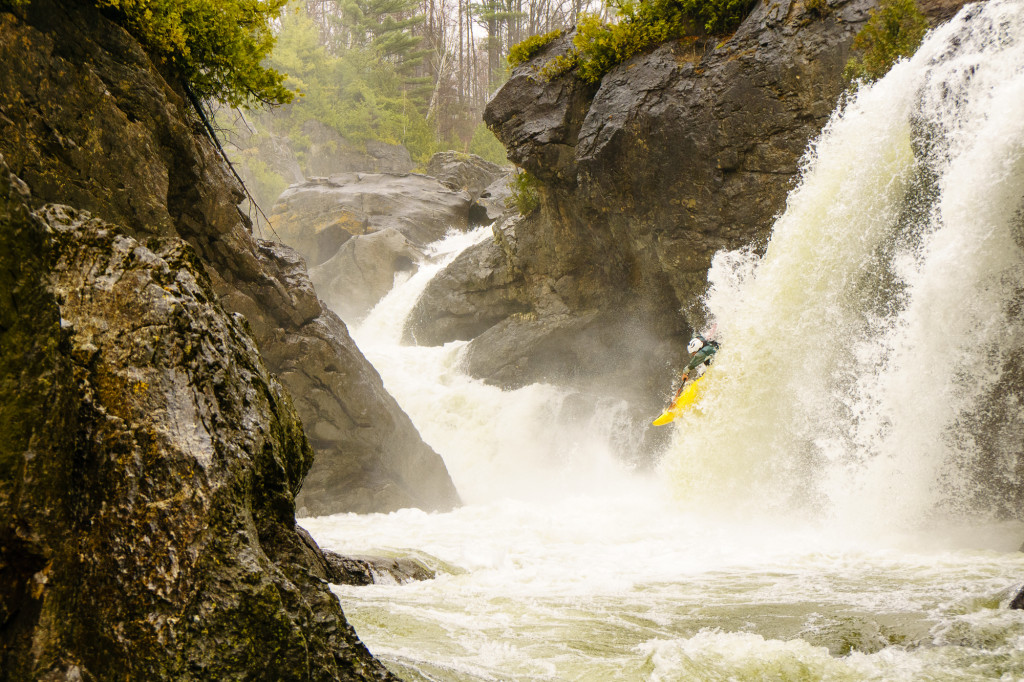
Roxbury, Vermont
A college friend grew up near here and told me about this one. That same friend made a kayak film in 2003 called “White Noise.” At the end he included some footage of this waterfall with the words “To Future Possibilities.” Yours truly was one of the paddlers in this film, and back then we all wanted a piece of this waterfall. It was at least 30 feet tall — maybe 35 — and was located on sketchy private land on an obscure micro-creek that looked like a drainage ditch from the road. It was called Sandusky Brook, and it required Biblical rains to run. For a time there during the winter of ’03-04, everyone was talking it. I don’t think I’ve ever had a waterfall or river on my hit list that I wanted to do so badly.
Well, it happened. We drove out there — perfect spring morning, perfect crew, perfect water level, height of my game . . . And I chickened out. The lip was just a little more exciting and the pool at the bottom a little smaller than I expected. In retrospect I hadn’t run any waterfalls over 20 feet at the time, so I didn’t have a lot of experience judging the variables that go along with something like this. So I didn’t run it. But nobody else ran it either. It took six years for someone to finally paddle off the lip. Nick Gottlieb from Dartmouth made the first descent. As far as I know, nobody has made a second.
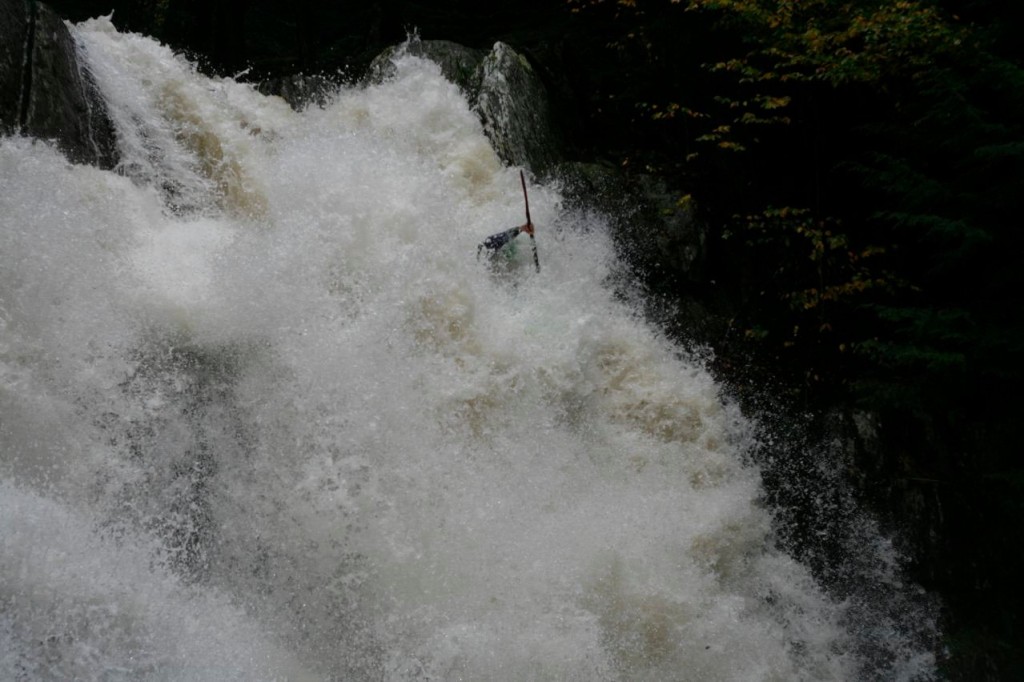
Jackson, New Hampshire
I thought for sure I was going to get sued.
Glen Ellis Falls could not be more different than Sandusky. It’s one of the most famous waterfalls in New England. It has a tourist pull-off in the shadow of Mt. Washington, and a wide, friendly boardwalk leading out to it from the road. It’s 65 feet tall with a weird 10-foot entrance drop. It’s stunning, really, that it was ever run in a kayak.
That descent, at very low water, was made sometime in the late 90s or early 2000s. I chronicled this event and included a large photo of Glen Ellis Falls in my 2008 guidebook, Let It Rain.
When you write a guidebook, you include stuff like that because it’s interesting lore, not because you’re necessarily trying to endorse it. After all, I also ran photos of Jessie Sharp making the first descent of Niagara Falls in 1990 — a descent from which he never returned. It’s part of Northeast legend. I wasn’t endorsing it.
So imagine my horror two years after my book came out when a young Dartmouth boater, Xavier Engel, repeated the Glen Ellis Falls descent — this time at a healthy spring water level. At first all I knew was that he’d tried it and it had not gone well. I didn’t know if he’d gotten hurt, or gotten in trouble, or what. My thoughts immediately went to the worst-case scenario. I had nightmares of this guy sitting in his truck beforehand with a copy of my book, staring at that picture and murmuring, “I don’t see a disclaimer . . . Must mean it’s okay . . . If not at least my father is a trial lawyer . . . ” For about twenty-four hours I considered just filing for bankruptcy preemptively, or slipping out of the country and returning under an assumed name (LaMarcus Bird, De’Alden Bird).
Once I did learn that Engel was okay, I felt a little better. That doesn’t stop me from still having nightmares about lawsuits though. Usually it’s some UVM undergraduate paddling haplessly toward Huntington Gorge because as he was staring at Let It Rain the night before, his bong was in the way of the disclaimer. Then I just tell myself that nobody really reads books, especially college kids. And that makes me feel better.
Here’s the video of Engel running Glen Ellis Falls. Although on this day all was fine, this story has a sad postscript. A few years ago Xavier Engel, by then a medical student, died on a river in Washington State. I regret not getting to meet him to tell him how terrified I was when his hit list brought him to Glen Ellis.
Glen Ellis Falls from Jeff Sharpe on Vimeo.
Manchester, Vermont
Here’s one that still hasn’t been run, even though it has been on a lot of good boaters’ hit lists since the mid-2000s. Airbourne Falls — called “Downer Glen” on the Northeast Waterfalls site — is a still-unrun 40-foot waterfall on Bourne Brook in Manchester, Vermont. At one time, I spent a lot of time down in Bourne Brook — hiked in there a few times, once in the winter, mapped all the rapids. But Bourne is a committing undertaking. It takes a whole day, requires some major, sketchy portages, is more than mildly terrifying, especially if the water level in there rises even a little, and basically if you’re not careful it can turn into a boat-assisted rappel, a broken something, or a night out in the woods. It’s a lot. That’s what kept me away, and that’s probably why Airbourne has never been run. There have been maybe seven or eight descents of the creek, ever. And like the Garden of the Gods down in Asheville, a lot of good, good boaters have passed on Airbourne Falls.

The last descent that I know of was made in 2013 by Ryan Mooney, Nick Gottlieb, and Justin Beckwith. With daylight scarce, they portaged Airbourne. “It’ll get run one of these days, though,” wrote Gottlieb.
It’s still out there — waiting to be on someone’s hit list. It runs a lot.
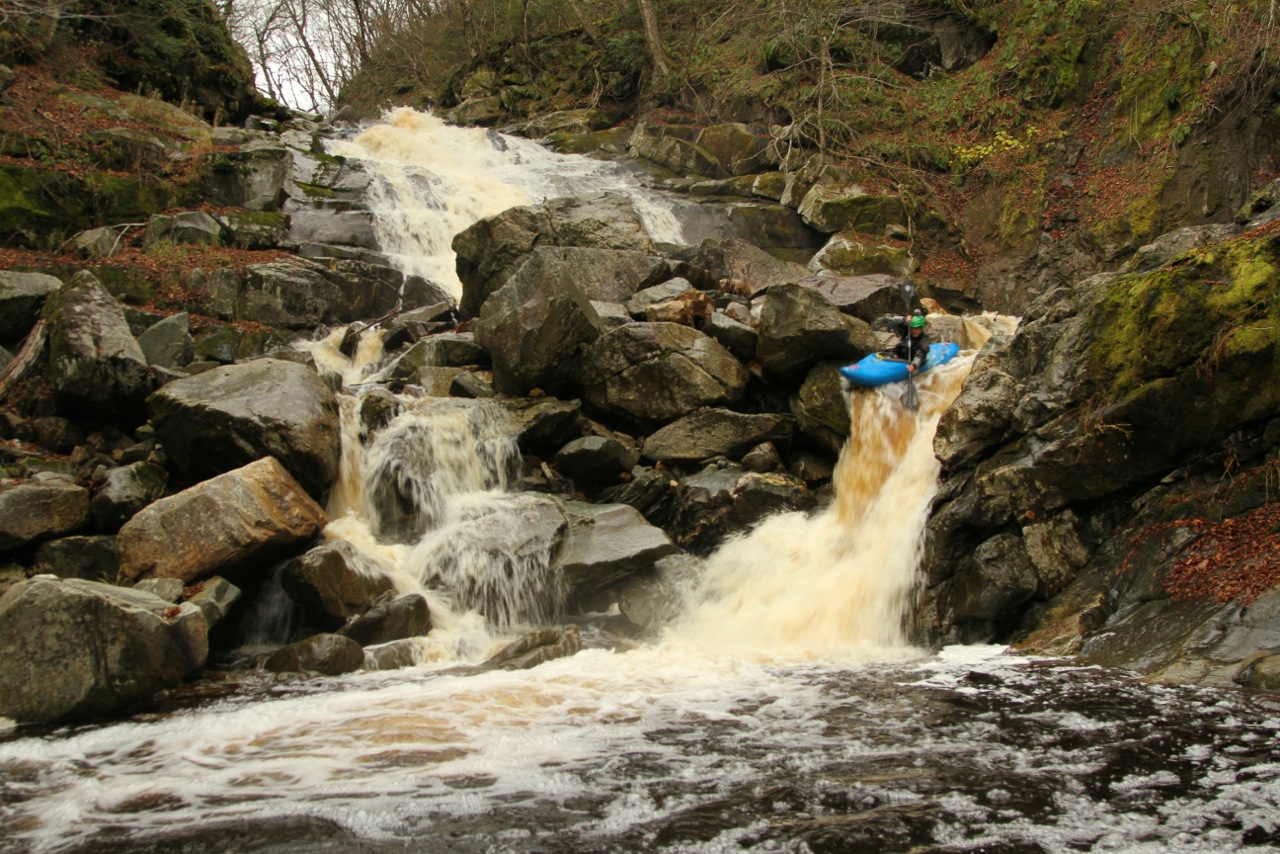
6. Hanging Spear Falls
Adirondacks, New York State
Yeah, I was a little disappointed when Pat Keller and Steve Fisher grabbed this one.
Right at the top of many hit lists for years and years was Hanging Spear Falls, a 60-70 foot waterfall on the Opalescent River, high in the Adirondack Mountains. I first heard about this river from New York state kayaking legend and guidebook author Dennis Squires, who explored it back in the 1990s, I believe. Nobody had run the big falls though, and for a long time, a lot of guys wanted to.
When Fisher and Keller made the first descent a few years ago, it was sort of like Russell Westbrook and Kevin Durant stopping by to win your town’s big 2-on-2 basketball tournament. You have to respect their abilities, but it just feels wrong for them to swoop in and collect the trophy. I wish it had been some local Adirondack boater who got to paddle off the lip first after scouting it for years, not two famous guys who already have enough first descents to their names.
Plus, while I admire Pat Keller, I’ve never liked Steve Fisher, going back to when he took some gratuitous shots at slalom racing in a magazine years ago. His Red Bull Athlete Bio advertises him as “a man that boldly goes where no man has gone before – in a kayak, that is.” I think that about says it all.

While the film that he made about Hanging Spear had some beautiful footage, it felt oddly opportunist, like here was a career kayaker who’d searched for a first descent that he could make into a video in order to create “content” for his sponsors. The Red Bull YouTube channel, where this video was aired, reads: “Experience the world of Red Bull like you have never seen it before . . . Prepare for your ‘stoke factor’ to be at an all time high.” After watching this video, I can’t say that my stoke factor was at an all time high, but the hype factor clearly was.
Just look at the product placement at 3:10 in the video. Someone explain to me why they have cans of Red Bull on the table while they’re drinking beers? And why didn’t Matt get one? Did they only provide cans for their sponsored crew?
Look closely at that same scene though and you’ll see that I shouldn’t complain. I too was beneficiary of some product placement in that scene, albeit wholly unlooked for. Shortly before the video came out, I got an email from one of the guys who helped make it, asking me to sign a release allowing Red Bull Media House to be able to “distribute and exhibit [my book] throughout the universe, in any and all media and by all technology (now known or here after developed) in perpetuity” (emphasis mine). Well then. “Throughout the universe”? If that’s the case I wish my sales on Jupiter were a little stronger! And all technology developed in the future, ever? Maybe they’ll be beaming my book directly into your brains some day, along with subliminal messages to drink Red Bull. Considering that those guys certainly weren’t using my book to get into Hanging Spear, I guess this all worked out in my favor.
Plus I’m not really one to talk. I once inadvertently allowed Red Bull to use a huge boater party at my house in Washington, D.C. to promote their product. This was the year Red Bull inflated a giant banner across the lip of Gorilla during the Green Narrows race. They were trying to brand themselves as an extreme sport drink, so they donated cases and cases of Red Bull to the big party I was having, which was sort of co-sponsored by one of the big kayak companies. That night included a film screening of the latest LVM video, several kegs of beer that I definitely did not pay for, most of the kayakers in the greater D.C. area, a large number of people making “personal first descents” of a new drink called Red Bull and Vodka (with varying levels of carnage), and a few select moments after about 8 pm that evening which I was actually able to recall once I woke up two days later. After the party was over, we had enough Red Bull left over to last us for weeks and to affect our sleep patterns for years to come.
7. Brokeback Gorge
Lowville, New York
When pictures of Eric Adsit’s and Taylor Krammen’s first descent of the upper section of Roaring Brook started flying around Facebook back in 2010, all I could think about was two things: 1) Whoa, is that even scoutable? And, 2) Why did they name it “Brokeback”?
The answer to the first question is, “Not really.” One Whistle Falls, which drops about 45 feet and was named because on the first descent they agreed to give “one whistle if it’s good, three if you died,” is virtually impossible to scout or portage once you commit.
And “Brokeback”? The answer to the second question is that Adsit and Krammen were fairly concerned about breaking something off the big falls, plus it was just the two of them in in there and the name seemed funny.
This is a real hit list item made good, and I was floored when I first saw the photos. This must have been what it was like back in the 90s when guys were first running all the classics of New England — the Upper Pemi, the New Haven Ledges — if only they’d had digital cameras and social media.
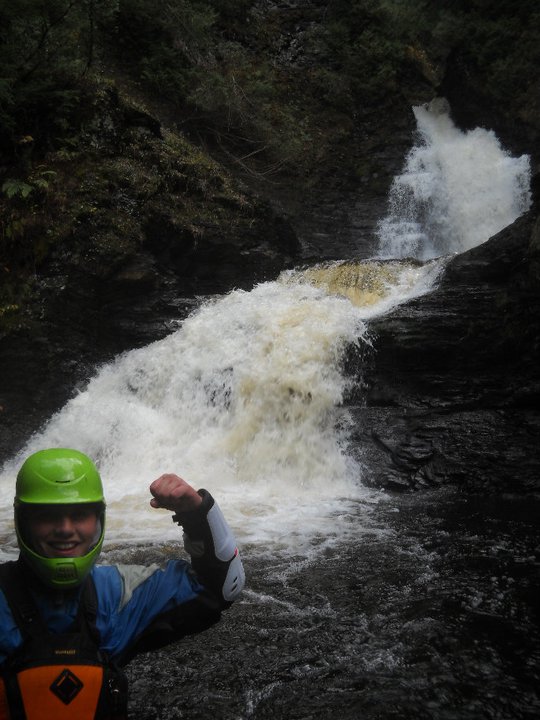
Conclusion: Go Make a Hit List
So that’s it: a little ode to the Hit List. Just a few examples of guys making good on their paddling hit list by dreaming big and then actually getting out there and making it happen with the logistics and with their boats. I hope their efforts inspire you to create your own hit list for this season, whether the sport is paddling or something else.
Stay tuned for next week’s Notes From the North Country post, in which I describe my own hit list for the upcoming spring paddling season. Because despite what people may have gleaned from previous articles, I’m not entirely broken up with paddling.
Cheers,
